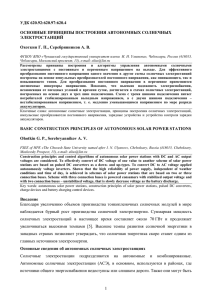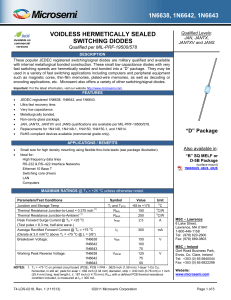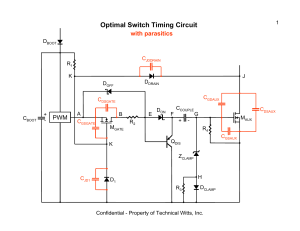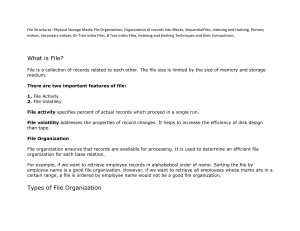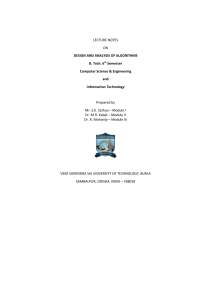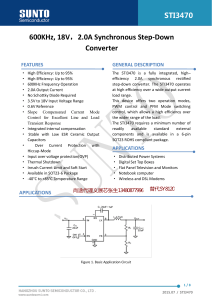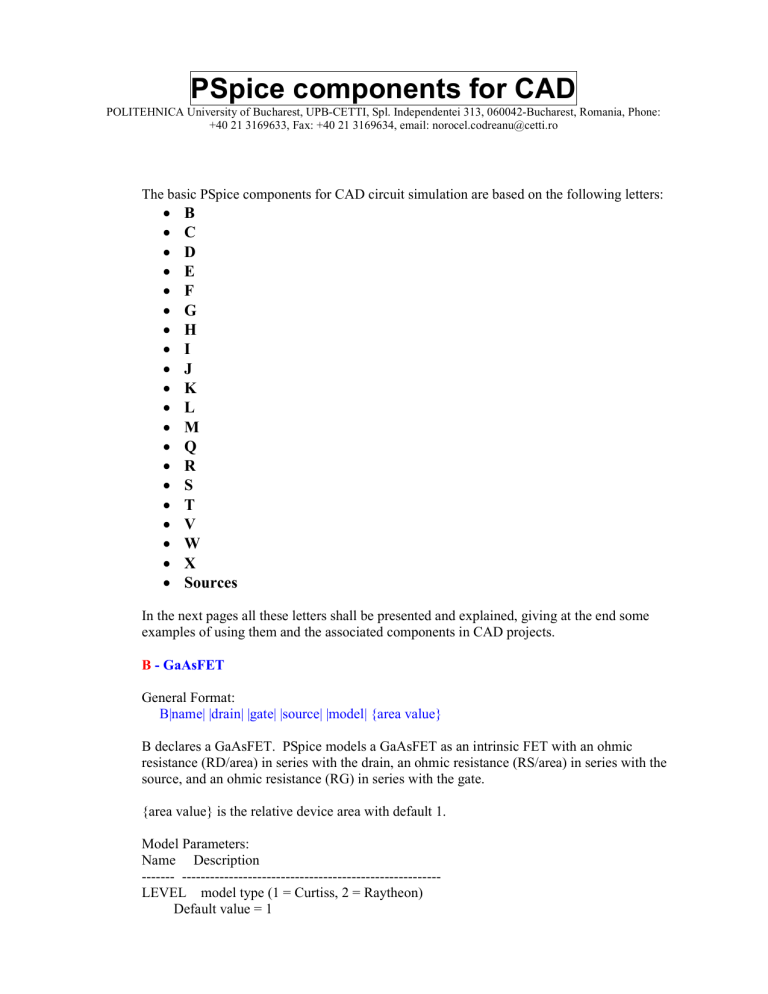
PSpice components for CAD POLITEHNICA University of Bucharest, UPB-CETTI, Spl. Independentei 313, 060042-Bucharest, Romania, Phone: +40 21 3169633, Fax: +40 21 3169634, email: [email protected] The basic PSpice components for CAD circuit simulation are based on the following letters: • • • • • • • • • • • • • • • • • • • • B C D E F G H I J K L M Q R S T V W X Sources In the next pages all these letters shall be presented and explained, giving at the end some examples of using them and the associated components in CAD projects. B - GaAsFET General Format: B|name| |drain| |gate| |source| |model| {area value} B declares a GaAsFET. PSpice models a GaAsFET as an intrinsic FET with an ohmic resistance (RD/area) in series with the drain, an ohmic resistance (RS/area) in series with the source, and an ohmic resistance (RG) in series with the gate. {area value} is the relative device area with default 1. Model Parameters: Name Description ------- ------------------------------------------------------LEVEL model type (1 = Curtiss, 2 = Raytheon) Default value = 1 VTO threshold voltage Default value = -2.5 ; Units = volt ALPHA tanh constant Default value = 2 ; Units = volt^-1 B doping tail extending parameter (level 2 only) Default value = .3 BETA transconductance coefficient Default value = 0.1 ; Units = amp/volt^2 LAMBDA channel-length modulation Default value = 0 ; Units = volt^-1 RG gate ohmic resistance Default value = 0 ; Units = ohm RD drain ohmic resistance Default value = 0 ; Units = ohm RS source ohmic resistance Default value = 0 ; Units = ohm IS gate p-n saturation current Default value = 1E-14 ; Units = amp M gate p-n grading coefficient Default value = 0.5 N gate p-n emission coefficient Default value = 1 VBI gate p-n potential Default value = 1 ; Units = volt CGD gate-drain zero-bias p-n capacitance Default value = 0 ; Units = farad CGS gate-source zero-bias p-n capacitance Default value = 0 ; Units = farad CDS drain-source zero-bias p-n capacitance Default value = 0 ; Units = farad TAU transit time Default value = 0 ; Units = sec FC forward bias depletion capacitance coefficient Default value = 0.5 VTOTC VTO temperature coefficient Default value = 0 ; Units = volt/ĄC BETATCE BETA exponential temperature coefficient Default value = 0 ; Units = %/ĄC KF flicker noise coefficient Default value = 0 AF flicker noise exponent Default value = 0 Examples: B1 100 1 0 MGAAS declares a GaAsFET B1 of model MGAAS B2 100 10 0 MGNOM 2.0 declares a GaAsFET B2 of model MGNOM and area multiplier of 2.0 C - Capacitor General Format: C|name| |+ node| |- node| {model name} |value| {IC = |initial value|} The |+ node| and |- node| define the polarity of the capacitor. Positive current flows from the |+ node| to the |- node|. {model name} is optional and if not included then |value| is the capacitance in farads. If {model name} is specified then the capacitance is given by : Ctot = |value|*C*(1+VC1*V+VC2*V^2)*[1+TC1*(T-Tnom))+TC2*(T-Tnom)^2] where C, VC1, VC2, TC1, and TC2 are described below. Ctot is the total capacitance. V is the voltage across the capacitor. T is the simulation temperature. And Tnom is the nominal temperature (27C unless set by .OPTIONS TNOM command) |value| can either be positive or negative. {IC = |initial value|} gives PSPICE an initial guess for voltage across the capacitor during bias point calculation and is optional. The capacitor does not have a noise model. Model Parameters : Name Description ------- ------------------------------------------------------C capacitance multiplier Default value = 1 VC1 linear voltage coefficient Default value = 0 ; Units = volt^-1 VC2 quadratic voltage multiplier Default value = 0 ; Units = volt^-2 TC1 linear temperature coefficient Default value = 0 ; Units = ĄC^-1 TC2 quadratic temperature coefficient Default value = 0 ; Units = ĄC^-2 Example : C1 1 0 20pF defines a 20pF capacitor between nodes 1 and 0. D - Diode General Format: D|name| |+ node| |- node| |model name| {area value} The diode is modeled by a resistor of value RS/{area value} in series with an intrinsic diode. |+ node| is the anode and |- node|is the cathode. Positive current flows from the anode to cathode. {area value} scales IS, RS, CJO, and IBV and is 1 by default. IBV and BV are both positive. Model Parameters : Name Description ------- ------------------------------------------------------IS saturation current Default value = 1E-14 ; Units = amp N emission coefficient Default value = 1 RS parasitic resistance Default value = 0 ; Units = ohm CJO zero-bias p-n capacitance Default value = 0 ; Units = farad VJ p-n potential Default value = 1 ; Units = volt M p-n grading coefficient Default value = 0.5 FC forward bias depletion capacitance coefficient Default value = 0.5 TT transit time Default value = 0 ; Units = sec BV reverse breakdown value Default value = infinite ; Units = volt IBV reverse breakdown current Default value = 1E-10 ; Units = amp EG bandgap voltage Default value = 1.11 ; Units = eV XTI IS temperature exponent Default value = 3 KF flicker noise coefficient Default value = 0 AF flicker noise exponent Default value = 1 Example: D1 1 2 DMOD defines a diode having model DMOD's characteristics with node 1 as its anode and node 2 as its cathode. E - Voltage-Controlled Voltage Source General Formats : E|name| |+ node| |- node| |+ control node| |- control node| |gain| or E|name| |+ node| |- node| POLY(|value|) (|+ control node|, |- control node| ...) + |polynomial coefficient value ...| Both formats declare a voltage source whose magnitude is related to the voltage difference between nodes |+ control node| and |- control node|. The first form generates a linear relationship. Thus : Vtot = |gain|*(|+control node|-|- control node|) where Vtot is the voltage between nodes |+ node| and |- node|. The second form generates a nonlinear response. The dimension of the polynomial is given by the |value|. The dimension means the number of pairs of controlling nodes. In all cases positive current flows from |+ node| through the source and out |- node|. Examples : E1 1 2 3 4 10 gives V(1) - V(2) = 10 * (V(3) - V(4)) E2 5 6 POLY(1) (7,8) 10 20 30 gives V(5) - V(6) = 10 + 20 * (V(7) - V(8)) + 30 * (V(7) - V(8))^2 E3 1 2 POLY(2) (3,4) (5,6) 10 20 30 gives V(1) - V(2) = 10 + 20 * (V(3) - V(4)) + 30 * (V(5) - V(6)) F - Current-Controlled Current Source General Formats : F|name| |+ node| |- node| + |controlling V source| |gain| or F|name| |+ node| |- node| POLY(|value|) + (|controlling V source| ...) + |polynomial coefficient value ...| Both formats declare a current source whose magnitude is related to the current passing thru |controlling V source|. This means that the controlling current must flow through an independent voltage source. If it does not do so in the original circuit, then a 0-V independent voltage source must be added to the circuit in series with the branch where the controlling current exists, so that the controlling current is forced to flow through it. The orientation of this source must be such that its polarity satisfies the passive sign convention with respect to the current of interest. The first form generates a linear relationship. Thus: Itot = |gain|*I(|controlling V source|) where Itot is the total current thru the declared F|name| device. The second form generates a nonlinear response. The dimension of the polynomial is given by the |value|. The dimension means the number of |controlling V source|. In all cases positive current flows from |+ node| through the source and out |- node|. Examples : F1 1 2 VIN 10 gives I(F1) = 10 * I(VIN) F2 5 6 POLY(1) VIN 10 20 30 gives I(F2) = 10 + 20 * I(VIN) + 30 * (I(VIN)^2) F3 1 2 POLY(2) VA VB 10 20 30 gives I(F3) = 10 + 20 * I(VA) + 30 * I(VB) G - Voltage-Controlled Current Source General Formats : G|name| |+ node| |- node| |+ control node| |- control node| |transconductance| or G|name| |+ node| |- node| POLY(|value|) (|+ control node|, |- control node| ...) + |polynomial coefficient value ...| Both formats declare a current source whose magnitude is related to the voltage difference between nodes |+ control node| and |- control node|. The first form generates a linear relationship. Thus: Itot = |transconductance|*(|+control node|-|- control node|) where Itot is the current thru declared device G|name|. The second form generates a nonlinear response. The dimension of the polynomial is given by the |value|. The dimension means the number of pairs of controlling nodes. In all cases positive current flows from |+ node| through the source and out |- node|. Examples : G1 1 2 3 4 10 gives I(G1) = 10 * (V(3) - V(4)) G2 5 6 POLY(1) (7,8) 10 20 30 gives I(G2) = 10 + 20 * (V(7) - V(8)) + 30 * (V(7) - V(8))^2 G3 1 2 POLY(2) (3,4) (5,6) 10 20 30 gives I(G3) = 10 + 20 * (V(3) - V(4)) + 30 * (V(5) - V(6)) H - Current-Controlled Voltage Source General Formats : H|name| |+ node| |- node| |controlling V source| |transresistance| or H|name| |+ node| |- node| POLY(|value|) (|controlling V source| ...) + |polynomial coefficient value ...| Both formats declare a voltage source whose magnitude is related to the current passing thru |controlling V source|. This means that the controlling current must flow through an independent voltage source. If it does not do so in the original ircuit, then a 0-V independent voltage source must be added to the circuit in series with the branch where the controlling current exists, so that the controlling current is forced to flow through it. The orientation of this source must be such that its polarity satisfies the passive sign convention with respect to the current of interest. The first form generates a linear relationship. Thus : Vtot = |transresistance|*I(|controlling V source|) where Vtot is the voltage across |+ node| and |- node|. The second form generates a nonlinear response. The dimension of the polynomial is given by the |value|. The dimension means the number of |controlling V source|. In all cases positive current flows from |+ node| through the source and out |- node|. Examples : H1 1 2 VIN 10 gives V(1) - V(2) = 10 * I(VIN) H2 5 6 POLY(1) VIN 10 20 30 gives V(5) - V(6) = 10 + 20 * I(VIN) + 30 * (I(VIN)^2) H3 1 2 POLY(2) VA VB 10 20 30 gives V(1) - V(2) = 10 + 20 * I(VA) + 30 * I(VB) I - Independent Current Source General Formats: I|name| |+ node| |- node| {DC} |value| or I|name| |+ node| |- node| AC |magnitude| {phase} or I|name| |+ node| |- node| [transient specification] I declares a current source. There are three types of current sources. DC, AC, or transient sources. DC sources give a current source with constant magnitude current. DC sources are used for supplies or for DC analyses. AC sources are used for the .AC analysis. The magnitude of the source is given by |magnitude|. The initial phase of the source is given by {phase}, default phase is 0. Transient sources are sources whose output varies over the time of simulation. These are used mostly with the transient analysis, .TRAN. Transient sources must be defined as one of the below: EXP |parameters| PULSE |parameters| PWL |parameters| SFFM |parameters| SIN |parameters| Positive current flows from |+ node| thru the source and out |- node|. Examples: I1 1 2 3mA declares I1 as a DC source of magnitude 3mA I2 3 4 AC 1 declares I2 an AC source of magnitude 1A (0 initial phase) I3 5 6 SIN (1 .1 1MEG) declares I3 a sinusoidal source with magnitude .1A peak, frequency 1 MHz, and DC offset 1A . I4 7 8 DC 1 AC 1 declares I4 as a DC source with magnitude of 1A along with an AC component of magnitude 1A (phase angle = 0) J - Junction FET General Format: J|name| |drain| |gate| |source| |model| {area} J declares a JFET. The JFET is modeled as an intrinsic FET with an ohmic resistance (RD/{area}) in series with the drain, an ohmic resistance (RS/{area}) in series with the source, and an ohmic resistance (RG) in series with the gate. Positive current is defined as flowing into each terminal. {area}, optional, is the relative device area. Its default is 1. Model Parameters : Name Description ------- ------------------------------------------------------VTO threshold voltage Default value = -2.0 ; Units = volt BETA transconductance coefficient Default value = 1E-4 ; Units = amp/volt^2 LAMBDA channel-length modulation Default value = 0 ; Units = volt^-1 RD drain ohmic resistance Default value = 0 ; Units = ohm RS source ohmic resistance Default value = 0 ; Units = ohm IS gate p-n saturation current Default value = 1E-14 ; Units = amp CGD gate-drain zero-bias p-n capacitance Default value = 0 ; Units = farad CGS gate-source zero-bias p-n capacitance Default value = 0 ; Units = farad FC forward bias depletion capacitance coefficient Default value = 0.5 VTOTC VTO temperature coefficient Default value = 0 ; Units = volt/ĄC BETATCE BETA exponential temperature coefficient Default value = 0 ; Units = %/ĄC KF flicker noise coefficient Default value = 0 AF flicker noise exponent Default value = 0 Example: J1 1 2 3 MJFET declares a JFET with drain, gate, source nodes as node 1, node 2, node 3 respectively. MJFET is the model name of the JFET and must be declared by the .MODEL command. K - Inductor Coupling (Transformer Core) General Formats: K|name| L|inductor name| |L|inductor name|... |coupling value| or K|name| |L|inductor name|...| |coupling value| |model name| {size value} K couples two or more inductors together. Using the dot convention, place a dot on the first node of each inductor. Then the coupled current will be of opposite polarity with respect to the driving current. |coupling value| is the coefficient of mutual coupling. It must be between 0 and 1. If |model name| is present 4 things change : 1. The mutual coupling inductor becomes a nonlinear magnetic core. 2. The core's B-H characteristics are analyzed using the Jiles-Atherton model. 3. The inductors become windings, thus the number specifying inductance now means number of turns. 4. The list of coupled inductors may just be one inductor. {size value} scales the magnetic cross section, it's default is 1. Model Parameters : Name Description ------- ------------------------------------------------------AREA mean magnetic cross section Default value = 0.1 ; Units = cm^2 PATH mean magnetic path length Default value = 1 ; Units = cm GAP effective air gap length Default value = 0 ; Units = cm PACK pack(stacking) factor Default value = 1 MS magnetization saturation Default value = 1E6 ; Units = amp/meter ALPHA mean field parameter Default value = 0.001 A shape parameter Default value = 1000 ; Units = amp/meter C domain wall flexing coefficient Default value = 0.2 K domain wall pinning constant Default value = 500 Example: K1 L1 L2 0.9 defines the mutual coupling between inductors L1 and L2 as 0.9. L1 and L2 should both be declared somewhere in the netlist. L - Inductor General Format: L|name| |+ node| |- node| {model name} |value| {IC = |initial value|} L defines an inductor. |+ node| and |- node| define the polarity of positive voltage drop. Positive current flows from the |+ node| thru the device and out the |- node|. |value| can be positive or negative but not 0. {model name} is optional. If left out the inductor has an inductance of |value| henries. If {model name} is included, then the total inductance is: Ltot=|value|*L*(1+IL1*I+IL2*I^2)*(1+TC1*(T-Tnom)+TC2*(T-Tnom)^2) where L, IL1, IL2, TC1, and TC2 are defined in the model declaration. T is the temperature of simulation. Tnom is the nominal temperature (27ĄC unless specified by .OPTIONS TNOM) {IC = |initial value|} is optional and, if used, defines the initial guess for the current thru the inductor when PSPICE attempts to find the bias point. Model Parameters : Name Description ------- ------------------------------------------------------L inductance multiplier Default value = 1 IL1 linear current coefficient Default value = 0 ; Units = amp^-1 IL1 quadratic current coefficient Default value = 0 ; Units = amp^-2 TC1 linear temperature coefficient Default value = 0 ; Units = ĄC^-1 TC2 quadratic temperature coefficient Default value = 0 ; Units = ĄC^-2 Example: L1 1 2 10m defines an inductor between nodes 1 and 2 with inductance of 10mH. M - MOSFET General Format : M|name| |drain| |gate| |source| |substrate| |model name| {L = |value|} {W = |value|} {AD = + |value|} {AS = |value|} {PD = |value|} {PS = |value|} {NRD = |value|} {NRS = |value|} + {NRG = |value|} {NRB = |value|} M defines a MOSFET transistor. The MOSFET is modeled as an intrinsic MOSFET with ohmic resistances in series with the drain, source, gate, and substrate(bulk). There is also a shunt resistor (RDS) in parallel with the drain-source channel. Positive current is defined to flow into each terminal. L and W are the channel's length and width. L is decreased by 2*LD and W is decreased by 2*WD to get the effective channel length and width. L and W can be defined in the device statement, in the model, or in .OPTION command. The device statement has precedence over the model which has precedence over the .OPTIONS. AD and AS are the drain and source diffusion areas. PD and PS are the drain and source diffusion parameters. The drain-bulk and source-bulk saturation currents can be specified by JS (which in turn is multiplied by AD and AS) or by IS (an absolute value). The zero-bias depletion capacitances can be specified by CJ, which is multiplied by AD and AS, and by CJSW, which is multiplied by PD and PS, or by CBD and CBS, which are absolute values. NRD, NRS, NRG, and NRB are relative resistivities of their respective terminals in squares. These parasitics can be specified either by RSH (which in turn is multiplied by NRD, NRS, NRG, or NRB) or by absolute resistances RD, RG, RS, and RB. Defaults for L, W, AD, and AS may be set using the .OPTIONS command. If .OPTIONS is not used their default values are 100u, 100u, 0, and 0 respectively Model Parameters : Name Description ------- ------------------------------------------------------LEVEL model type (1, 2, or 3) Default value = 1 L channel length Default value = DEFL ; Units = meter W channel width Default value = DEFW ; Units = meter LD lateral diffusion (length) Default value = 0 ; Units = meter WD lateral diffusion (width) Default value = 0 ; Units = meter VTO zero-bias threshold voltage Default value = 0 ; Units = volt KP transconductance Default value = 2E-5 ; Units = amp/volt^2 GAMMA bulk threshold parameter Default value = 0 ; Units = volt^0.5 PHI surface potential Default value = 0.7 ; Units = volt LAMBDA channel length modulation (LEVEL = 1 or 2) Default value = 0 ; Units = volt^-1 RD drain ohmic resistance Default value = 0 ; Units = ohm RS source ohmic resistance Default value = 0 ; Units = ohm RG gate ohmic resistance Default value = 0 ; Units = ohm RB substrate ohmic resistance Default value = 0 ; Units = ohm RDS drain-source ohmic resistance Default value = infinite ; Units = ohm RSH drain, source diffusion sheet resistance Default value = 0 ; Units = ohm/square IS bulk p-n saturation current Default value = 1E-14 ; Units = amp JS bulk p-n saturation current/area Default value = 0 ; Units = amp/meter^2 PB bulk p-n potential Default value = 0.8 ; Units = volt CBD bulk-drain zero-bias p-n capacitance Default value = 0 ; Units = farad CBS bulk-source zero-bias p-n capacitance Default value = 0 ; Units = farad CJ bulk p-n zero-bias bottom capacitance/area Default value = 0 ; Units = farad/meter^2 CJSW bulk p-n zero-bias bottom capacitance/area Default value = 0 ; Units = farad/meter^2 MJ bulk p-n bottom grading coefficient Default value = 0.5 MJSW bulk p-n sidewall grading coefficient Default value = 0.33 FC bulk p-n forward-bias capacitance coefficient Default value = 0.5 CGSO gate-source overlap capacitance/channel width Default value = 0 ; Units = farad/meter CGDO gate-drain overlap capacitance/channel width Default value = 0 ; Units = farad/meter CGBO gate-substrate overlap capacitance/channel length Default value = 0 ; Units = farad/meter NSUB substrate doping density Default value = 0 ; Units = 1/cm^3 NSS surface state density Default value = 0 ; Units = 1/cm^2 NFS fast surface state density Default value = 0 ; Units = 1/cm^2 TOX oxide thickness Default value = infinite ; Units = meter TPG gate material type : +1 = opposite of substrate -1 = same as substrate 0 = aluminum Default value = +1 XJ metallurgical junction depth Default value = 0 ; Units = meter UO surface mobility Default value = 600 ; Units = cm^2/(volt*sec) UCRIT mobility degradation critical field (LEVEL = 2) Default value = 1E4 ; Units = volt/cm UEXP mobility degradation exponent (LEVEL =2) Default value = 0 VMAX maximum drift velocity Default value = 0; Units = meter/sec NEFF channel charge coefficient (LEVEL = 2) Default value = 1 XQC fraction of channel charge attributed to drain Default value = 1 DELTA width effect on threshold Default value = 0 THETA mobility modulation (LEVEL = 3) Default value = 0 ; Units = volt^-1 ETA static feedback (LEVEL = 3) Default value = 0 KAPPA saturation field factor (LEVEL = 3) Default value = 0.2 KF Flicker noise coefficient Default value = 0 AF Flicker noise exponent Default value = 1 Examples : M1 1 2 3 0 MNMOS L=3u W=1u defines a MOSFET with drain node 1, gate node 2, source node 3, substrate node 0, channel length and width 3u and 1u respectively, and described further by model MNMOS (which is assumed to exist in the .MODEL statements) M2 4 5 6 0 MNMOS defines a MOSFET with drain node 4, gate node 5, source node 6, substrate node 0, and described further by model MNMOS (which is assumed to exist in the .MODEL statements) Q - Bipolar Transistor General Format : Q|name| |collector| |base| |emitter| {substrate} |model name| {area value} Q declares a bipolar transistor in PSpice. The transistor is modeled as an intrinsic transistor with ohmic resistances in series with the base, the collector (RC/{area value}), and with the emitter (RE/{area value}). {substrate} node is optional, default value is ground. Positive current is defined as flowing into a terminal. {area value} is optional (used to scale devices), default is 1. The parameters ISE and ISC may be set greater than 1. If so they become multipliers of IS (i.e. ISE*IS). Model Parameters : Name Description ------- ------------------------------------------------------IS p-n saturation current Default value = 1E-16 ; Units = amp BF ideal maximum forward beta Default value = 100 NF forward current emission coefficient Default value = 1 VAF forward Early voltage Default value = infinite ; Units = volt IKF corner for forward beta high current roll off Default value = infinite ; Units = amp ISE base-emitter leakage saturation current Default value = 0 ; Units = amp NE base-emitter leakage emission coefficient Default value = 1.5 BR ideal maximum reverse beta Default value = 1 NR reverse current emission coefficient Default value = 1 VAR reverse Early voltage Default value = infinite ; Units = volt IKR corner for reverse beta high current roll off Default value = infinite ; Units = amp ISC base-collector leakage saturation coefficient Default value = 0 ; Units = amp NC base-collector leakage emission coefficient Default value = 2.0 RB zero-bias (maximum) base resistance Default value = 0 ; Units = ohm RBM minimum base resistance Default value = RB ; Units = ohm IRB current at which RB falls halfway to RBM Default value = infinite ; Units = amp RE emitter ohmic resistance Default value = 0 ; Units = ohm RC collector ohmic resistance Default value = 0 ; Units = amp CJE base-emitter zero-bias p-n capacitance Default value = 0; Units = farad VJE base-emitter built in potential Default value = 0.75 ; Units = volt MJE base-emitter p-n grading coefficient Default value = 0.33 CJC base-collector zero-bias p-n capacitance Default value = 0; Units = farad VJC base-collector built in potential Default value = 0.75 ; Units = volt MJC base-collector p-n grading coefficient Default value = 0.33 XCJC fraction of CJC connected internal to RB Default value = 1 CJS collector-substrate zero-bias p-n capacitance Default value = 0; Units = farad VJS collector-substrate built in potential Default value = 0.75 ; Units = volt MJS collector-substrate p-n grading coefficient Default value = 0 FC forward bias depletion capacitor coefficient Default value = 0.5 TF ideal forward transit time Default value = 0 ; Units = sec XTF transit time bias dependence coefficient Default value = 0 VTF transit time dependency on VBC Default value = infinite ; Units = volt ITF Transit time dependency on IC Default value = 0 ; Units = amp PTF excess phase at 1/(2*PI*TF) Hz. Default value = 0 ; Units = degree TR ideal reverse transit time Default value = 0 ; Units = sec EG bandgap voltage (barrier height) Default value = 1.11 ; Units = eV XTB forward and reverse bias temperature coefficient Default value = 0 XTI IS temperature effect exponent Default value = 3 KF Flicker noise coefficient Default value = 0 AF Flicker noise exponent Default value = 1 Example : Q1 1 2 3 MNPN defines a bipolar transistor of model MNPN with collector, base, and emitter nodes of 1, 2, and 3 respectively. R - Resistor General Format : R|name| |+ node| |- node| {model name} |value| The |+ node| and |- node| define the polarity of the resistor in terms of the voltage drop across it. Positive current flows from the |+ node| thru the resistor and out the |- node|. {model name} is optional and if not included then |value| is the resistance in ohms. If {model name} is specified and TCE is not specified then the resistance is given by : Rtot = |value|*R*[1+TC1*(T-Tnom))+TC2*(T-Tnom)^2] where R, TC1, and TC2 are described below. Rtot is the total resistance, T is the simulation temperature and Tnom is the nominal temperature (27C unless set by .OPTIONS TNOM command) If TCE is specified then the resistance is given by: Rtot = |value|*R*1.01^(TCE*(T-Tnom)) |value| can either be positive or negative. Noise is calculated using a 1 Hz bandwidth. The resistor generates thermal noise with the following spectral power density (per unit BW): i^2 = 4*k*T/resistance where k is Boltzmann's constant. Model Parameters : Name Description ------- ------------------------------------------------------R resistance multiplier Default value = 1 TC1 linear temperature coefficient Default value = 0 ; Units = ĄC^-1 TC2 quadratic temperature coefficient Default value = 0 ; Units = ĄC^-2 TCE exponential temperature coefficient Default value = 0 ; Units = %/ĄC Example : R1 1 0 20 defines a 20 ohm resistor between nodes 1 and 0. S - Voltage-Controlled Switch General Format : S|name| |+ switch node| |- switch node| |+ control node| |- control node| |model name| S denotes a voltage controlled switch. The resistance between |+ switch node| and |- switch node| depends on the voltage difference between |+ control node| and |- control node|. The resistance varies continuously between RON and ROFF. RON and ROFF must be greater than zero and less than GMIN (set in the .OPTIONS command). A resistor of value 1/GMIN is connected between the controlling nodes to prevent them from floating. Model Parameters : Name Description ------- ------------------------------------------------------RON on resistance Default value = 1 ; Units = ohm ROFF off resistance Default value = 1E6 ; Units = ohm VON control voltage for on state Default value = 1 ; Units = volt VOFF control voltage for off state Default value = 0 ; Units = volt Example : S1 1 2 3 4 MSW defines a current controlled switch. The resistance between nodes 1 and 2 varies with the voltage difference between nodes 3 and 4. The switch model is MSW. T - Transmission Line General Format : T|name| |+ A port| |- A port| |+ B port| |- B port| Z0 = |value| {TD = |TD value|} {F = |F value|{NL = |NL value|}} T defines a 2 port transmission line. The device is a bidirectional, ideal delay line. The two ports are A and B with their polarities given by the + or - sign. Z0 is the characteristic impedance of the line. The length of the transmission line can either be defined by TD, the delay in seconds, or by F and NL a frequency and relative wavelength. Example : T1 1 0 2 0 Z0=50 F=1E9 NL=0.25 declares a two port transmission line. The two ports are given as nodes 1 and 2. The line has a characteristic impedance of 50 ohms and a length of 0.25 wavelengths at 1 GHz. V - Independent Voltage Source General Formats : V|name| |+ node| |- node| {DC} |value| or V|name| |+ node| |- node| AC |magnitude| {phase} or V|name| |+ node| |- node| [transient specification] V declares a voltage source. There are three types of voltage sources. DC, AC, or transient sources. DC sources give a voltage source with constant magnitude voltage. DC sources are used for supplies or for DC analyses. AC sources are used for the .AC analysis. The magnitude of the source is given by |magnitude|. The initial phase of the source is given by {phase}, default phase is 0. Transient sources are sources whose output varies over the time of simulation. These are used mostly with the transient analysis, .TRAN. Transient sources must be defined as one of the below: EXP |parameters| PULSE |parameters| PWL |parameters| SFFM |parameters| SIN |parameters| Positive current flows from |+ node| thru the source and out |- node|. Examples : V1 1 2 1 declares V1 as a DC source of magnitude 1 V. V2 3 4 AC 1 declares V2 an AC source of magnitude 1 V (phase angle = 0) V3 5 6 SIN (1 .1 1MEG) declares V3 a sinusoidal source with magnitude .1 V peak, frequency 1 MHz, and DC offset 1 V . V4 7 8 DC 1 AC 1 declares V4 as a DC source with magnitude of 1 V along with an AC component of magnitude 1 V (phase angle = 0) W - Current-Controlled Switch General Format : W|name| |+ switch node| |- switch node| |controlling V source| |model name| W denotes a current controlled switch. The resistance between |+ switch node| and |- switch node| depends on the current flowing thru the control source |controlling V source|. The resistance varies continuously between RON and ROFF. RON and ROFF must be greater than zero and less than GMIN (set in the .OPTIONS command). A resistor of value 1/GMIN is connected between the controlling nodes to prevent them from floating. Model Parameters : Name Description ------- ------------------------------------------------------RON on resistance Default value = 1 ; Units = ohm ROFF off resistance Default value = 1E6 ; Units = ohm ION control voltage for on state Default value = 0.001 ; Units = amp IOFF control voltage for off state Default value = 0 ; Units = amp Example : W1 1 2 VCONT MSW defines a current controlled switch. The resistance between nodes 1 and 2 varies with the current flowing thru the control source VCONT. The switch model is MSW. X - Subcircuit Call General Format : X|name| {node ...} |subcircuit name| X calls the subcircuit |subcircuit name|. |subcircuit name| must somewhere be defined by the .SUBCKT and .ENDS command. The number of nodes (given by {node ...}) must be consistent. The referenced subcircuit is inserted into the given circuit with the given nodes replacing the argument nodes in the definition. Subcircuit calls may be nested but cannot be recursive. Example : X1 1 2 OPAMP calls the subcircuit OPAMP. SOURCES - Transient Source Descriptions There are several types of available sources for transient declarations. Each kind, its description, and an example is given below: 1. EXP - Exponential Source General Format : EXP (|v1| |v2| |td1| |td2| |tau1| |tau2|) The EXP form causes the voltage to be |v1| for the first |td1| seconds. Then it grows exponentially from |v1| to |v2| with time constant |tau1|. The growth lasts |td2| - |td1| seconds. Then the voltage decays from |v2| to |v1| with time constant |tau2|. Parameter Listing : Name Description ---- ------------------------------------------------------v1 initial voltage Default value = none ; Units = volt v2 peak voltage Default value = none ; Units = volt td1 rise delay time Default value = 0 ; Units = second tau1 rise time constant Default value = TSTEP ; Units = second td2 fall delay time Default value = td1 + TSTEP ; Units = second tau2 fall time constant Default value = TSTEP ; Units = second Example : V1 1 0 EXP(0 1 2u 10u 50u 10u) 2. PULSE - Pulse source General Format : PULSE(|v1| |v2| |td| |tr| |tf| |pw| |per|) Pulse generates a voltage to start at |v1| and hold there for |td| seconds. Then the voltage goes linearly from |v1| to |v2| for the next |tr| seconds. The voltage is then held at |v2| for |pw| seconds. Afterwards, it changes linearly from |v2| to |v1| in |tf| seconds. It stays at |v1| for the remainder of the period given by |per|. Parameter Listing : Name Description ---- ------------------------------------------------------v1 initial voltage Default value = none ; Units = volt v2 pulsed voltage Default value = none ; Units = volt td delay time Default value = 0 ; Units = second tr rise time Default value = TSTEP ; Units = second tf fall time Default value = TSTEP ; Units = second pw pulse width Default value = TSTOP ; Units = second per period Default value = TSTOP ; Units = second Example : V1 1 0 PULSE(0 5 2u 10u 10u 100u 300u) 3. PWL - Piecewise Linear Source General Format: PWL(|t1| |v1| |t2| |v2| .... |ti| |vi| ) PWL describes a piecewise linear format. Each pair of time/voltage (i.e. |t1|, |v1|) specifies a corner of the waveform. The voltage between corners is the linear interpolation of the voltages at the corners. Parameter Listing : Name Description ---- ------------------------------------------------------ti corner time Default value = none ; Units = second vi corner voltage Default value = none ; Units = volt Example : V1 1 0 PWL(0 0 1u 0 1.01u 5 10m 5) 4. SFFM - Single Frequency FM Source General Format : SFFM(|vo| |va| |fc| |mdi| |fs|) SFFM causes the voltage signal to follow : v=vo+va*sin(2*PI*fc*t+mdi*sin(2*PI*fs*t)) where vo, va, fc, mdi, and fs are defined below. t is time. Parameter Listing : Name Description ---- ------------------------------------------------------vo offset voltage Default value = none ; Units = volt va peak amplitude voltage Default value = none ; Units = volt fc carrier frequency Default value = 1/TSTOP ; Units = Hz mdi modulation index Default value = 0 fs signal frequency Default value = 1/TSTOP ; Units = Hz Example: V1 1 0 SFFM(3 1 88MEG 0.5 20k) 5. SIN - Sinusoidal Source General Format : SIN(|vo| |va| |freq| |td| |df| |phase|) SIN creates a sinusoidal source. The signal holds at |vo| for |td| seconds. Then the voltage becomes an exponentially damped sine wave described by : v=vo+va*sin(2*PI*(freq*(t-td)+phase/360))*e^-((t-td)*df) Parameter Listing : Name Description ---- ------------------------------------------------------vo offset voltage Default value = none ; Units = volt va peak amplitude voltage Default value = none ; Units = volt freq carrier frequency Default value = 1/TSTOP ; Units = Hz td delay Default value = 0 ; Units = second df damping factor Default value = 0 ; Units = second^-1 phase phase Default value = 0 ; Units = degree Example : V1 1 0 SIN(2 1 20k 1m 0 90) Note that the above functions can also be used to describe time varying current sources, just interchanging current for voltage.
